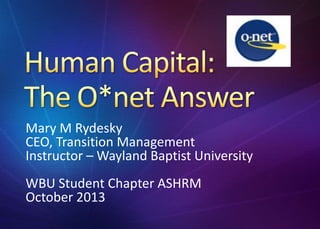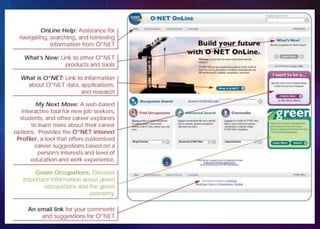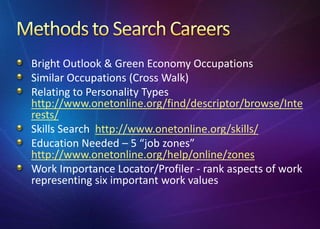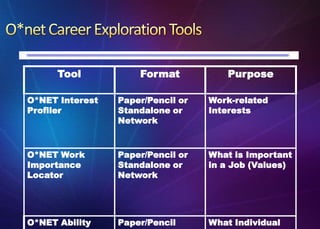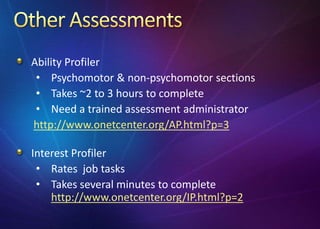O*net Career Management Tool
- 1. Mary M Rydesky CEO, Transition Management Instructor â Wayland Baptist University WBU Student Chapter ASHRM October 2013
- 2. Selecting education direction Graduating to first job Transitioning from military to civilian Transition from discipline to discipline Navigating career choices Adding a position
- 3. Yourself Values Motivators & Personality KSAs Industry/Field Choices NAICs Previous experience Occupations Current demand & projections How you fit
- 4. 975 occupations covering many important job qualities US Department of Labor â Bureau of Labor Statistics Provides data that is valid, reliable, standardized, & updated Portal for occupation experts to submit career information www.onetonline.org
- 6. Bright Outlook & Green Economy Occupations Similar Occupations (Cross Walk) Relating to Personality Types http://www.onetonline.org/find/descriptor/browse/Inte rests/ Skills Search http://www.onetonline.org/skills/ Education Needed â 5 âjob zonesâ http://www.onetonline.org/help/online/zones Work Importance Locator/Profiler - rank aspects of work representing six important work values
- 7. Tool Format Purpose O*NET Interest Profiler Paper/Pencil or Standalone or Network Work-related Interests O*NET Work Importance Locator Paper/Pencil or Standalone or Network What is Important in a Job (Values) O*NET Ability Paper/Pencil What Individual
- 9. Ability Profiler âĒ Psychomotor & non-psychomotor sections âĒ Takes ~2 to 3 hours to complete âĒ Need a trained assessment administrator http://www.onetcenter.org/AP.html?p=3 Interest Profiler âĒ Rates job tasks âĒ Takes several minutes to complete http://www.onetcenter.org/IP.html?p=2
- 11. Computation Arithmetic Reasoning Vocabulary Name Comparison Object Matching Three Dimensional Space Mark Making Place Turn Assemble Disassemble
- 15. Career Management Pick schools & courses Project future demand Understand vocabulary Talk KSAs Learn about salaries HR Management Use standardize terms Improve quality of JDs Improve efficiency Compare salaries Retain & grow workforce
- 17. âĒ âEducation Paysâ http://www.bls.gov/emp/ep_chart_001.htm âĒ Earnings & employment rates by education level âĒ http://www.census.gov/prod/2011pubs/acs-14.pdf âĒ Feb. 9, â12 article â gender gap in educational attainment http://www.bls.gov/opub/ted/2012/ted_20120210. htm âĒ http://www.census.gov/prod/2011pubs/acs-14.pd âEducation & Synthetic Work-Life Earnings Estimatesâ âĒ Wet Feet resourceshttp://www.wetfeet.com/advicetools/career-planning
- 18. O*Net www.Onetonline.org â comprehensive career info O*Net Academy http://www.onetacademy.org/ O*Net Desk Aid http://www.onetcenter.org/dl_files/desk_aid.pdf Monthly Labor Review http://stats.bls.gov/mlr/ Occupational Outlook Handbook http://www.bls.gov/oco/ Bureau of Labor Statistics http://www.bls.gov/home.htm âĒ Career One Stop http://www.careeronestop.org âĒ Local employment stats
- 19. Godfrey, E. O*net and Beyond (ppt), 2013 Mullins, J. Career planning: the second time around. (2009) http://www.bls.gov/opub/ooq/2009/summer/art0 2.pdf Wall, J. How to Interpret and Use the O*net Ability Profiler Results (ppt), 2007 Wall, J. Introduction to the O*net Career Exploration Tools (ppt), 2008
Editor's Notes
- #4: SOC Standard Occupational CodeThe 2010 Standard Occupational Classification (SOC) system is used by Federal statistical agencies to classify workers into occupational categories for the purpose of collecting, calculating, or disseminating data. All workers are classified into one of 840 detailed occupations according to their occupational definition. To facilitate classification, detailed occupations are combined to form 461 broad occupations, 97 minor groups, and 23 major groups. Detailed occupations in the SOC with similar job duties, and in some cases skills, education, and/or training, are grouped together.Next one due in 2018
- #6: Onet Orientation
- #7: How students and persons in career transition can use Onet
- #9: Hollands RAISEC model of personality â a key to a good fit in a career
- #15: The employerâs benefits: (from a case study) The time invested in developing the job description was reduced from anaverage of 24 hours to 8 hours. The cost to the employer was reduced dramatically from approximately$1,440 to approximately $480. The job description was created using a standardized and commonlanguage. The standardized language used made it much easier to compare workacross functions and levels. The new O*NET based description was of much higher quality than the lessspecific descriptions used in the past. Through O*NET OnLine links, the employer accessed additionalinformation on the Internet, such as current U.S. salaries, current andprojected employment, and related training.
- #20: O*NET for Job Seekers and StudentsO*NET Tools for Military in TransitionLinks between Occupations, Education, and Pay

